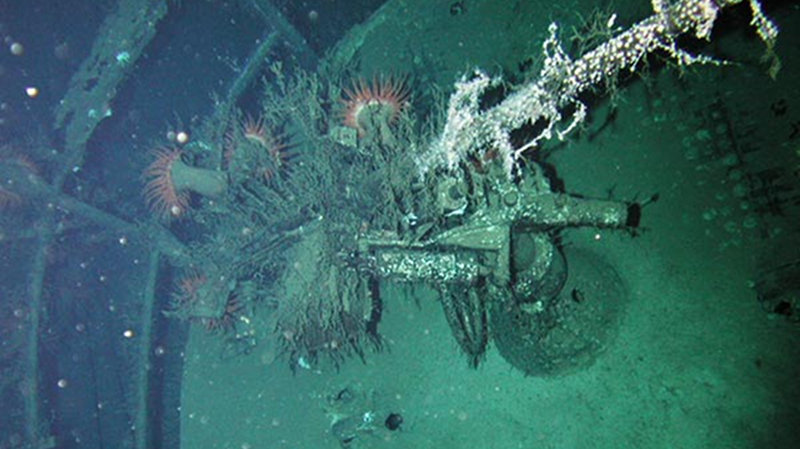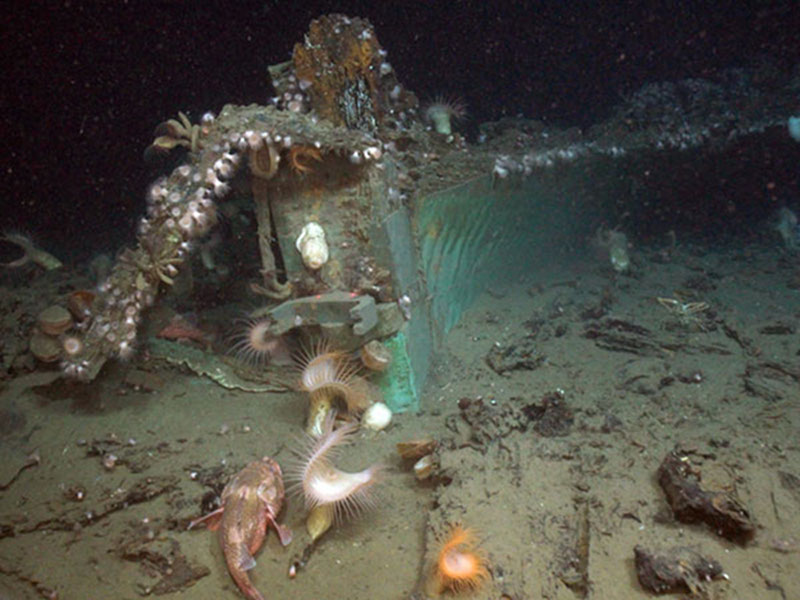
By Jack Irion - Bureau of Ocean Energy Management
September 27, 2012

A close-up of the U-166 "wintergarten," with its 20mm anti-aircraft gun, photographed during the World War II Gulf of Mexico Shipwreck Survey Expedition 2004. Image courtesy of the NOAA Okeanos Explorer Program. Download image (jpg, 87 KB).
Why is the Bureau of Ocean Energy Management (BOEM) interested in shipwrecks off the Virginia Coast? BOEM is the agency within the U.S. Department of the Interior responsible for managing oil and gas exploration and development and offshore renewable energy leases. It is charged by Congress with the duty of understanding and lessening or eliminating environmental impacts from that activity while ensuring America’s energy future.
In the past 20 years, most of the exploration for domestic energy sources offshore have centered in the Gulf of Mexico and, to a lesser extent, off California and Alaska. Recently, Mid-Atlantic States, such as Virginia, have expressed a greater interest in developing the energy potential off their own shores.

The snapped pintle on the sternpost of the Gulf Penn shipwreck, investigated during the Lophelia II 2009 expedition. Image courtesy of Sheli Smith, Lophelia II 2009: Deepwater Coral Expedition: Reefs, Rigs and Wrecks. Download image (jpg, 97 KB).
In order to plan for the future, BOEM initiated, in partnership with NOAA’s Office of Ocean Exploration and Research, a four-year study titled Exploration and Research of Mid-Atlantic Deepwater Hard Bottom Habitats and Shipwrecks with Emphasis on Canyons and Coral Communities. Why? Because knowledge of the distribution and sensitivity of unique biological habitats offshore Virginia is necessary for management decisions regarding consideration of potential oil and gas leasing and development in the Atlantic region. Results from this project will help to define mitigations to eliminate environmental impacts by avoiding hard-bottom areas and associated sensitive coral communities in deepwater.
In addition to its responsibilities for environmental protection, BOEM also has an obligation under the National Historic Preservation Act to safeguard significant archaeological sites, such as historic shipwrecks, during its permitting process. By locating and investigating shipwrecks in the Virginia Canyons study area, we will receive valuable information on the condition, state of preservation, and site formation processes in this area that will help us in the future to design methods to best locate and preserve these cultural resources.

An early to mid-19th century wooden-hulled shipwreck on the deep Gulf of Mexico seafloor, seen during the Okeanos Explorer: Gulf of Mexico 2012 Expedition. Image courtesy of the NOAA Okeanos Explorer Program. Download image (jpg, 58 KB).
BOEM has a long and successful history of collaboration with NOAA OER on joint archaeology/biology missions in deep water. Beginning with the award-winning Deep Wrecks Project in 2004, BOEM and NOAA OER collaborated on a study of the “artificial reef effect“ of man-made structures at progressively deeper water depths using vessels sunk in 1942 by German U-boats as their “laboratory.“ Included in the study was the only U-boat sunk during the war in the Northern Gulf of Mexico, the U-166. This successful study was followed in 2009 by the Lophelia II Deepwater Coral Expedition and the collaboration continued most recently during the 2012 Gulf of Mexico cruise of the research ship Okeanos Explorer.
By joining with NOAA OER in studying the shipwrecks of the Virginia Canyons, BOEM hopes to preserve a vital part of America’s history for future generations.